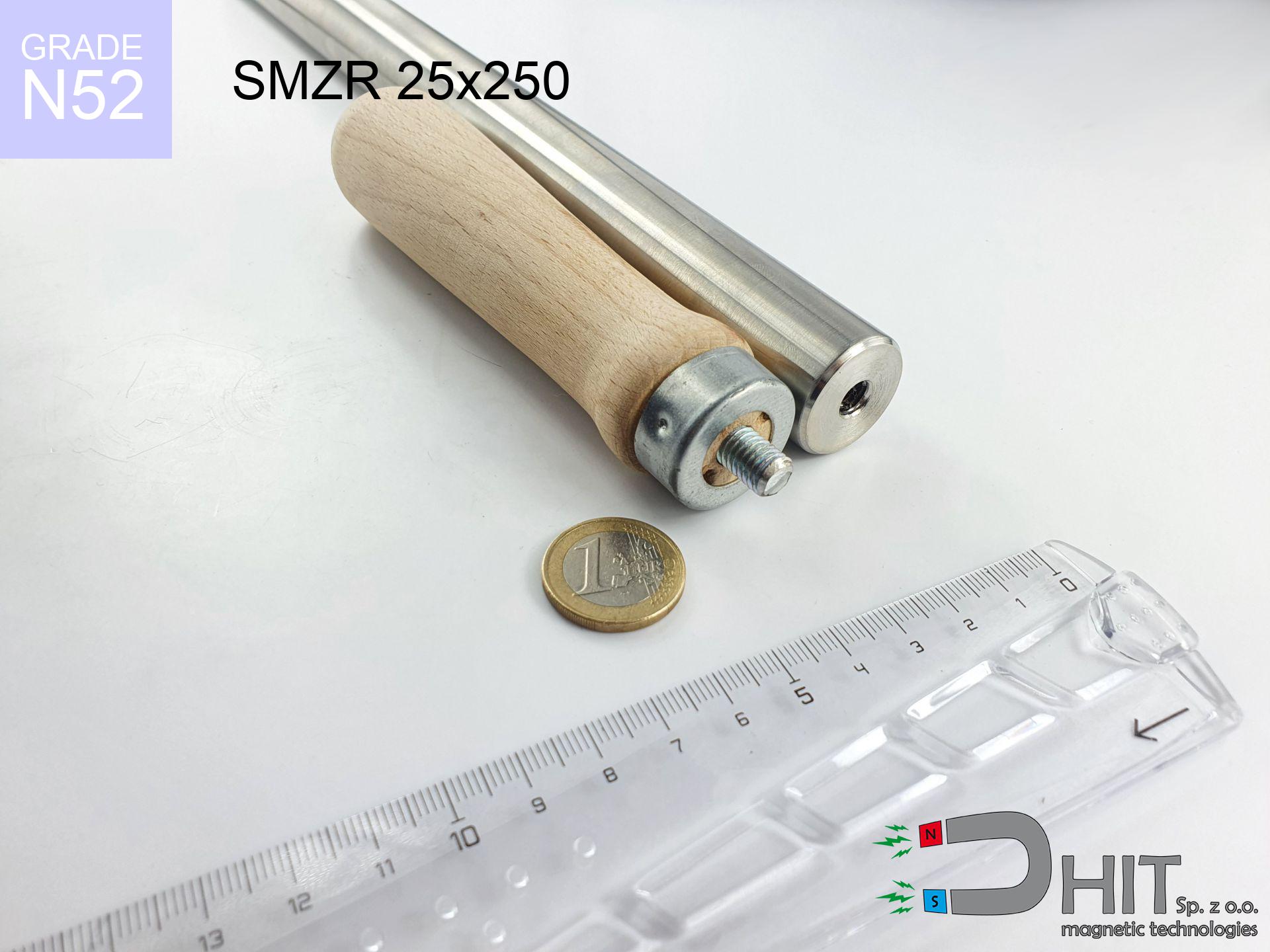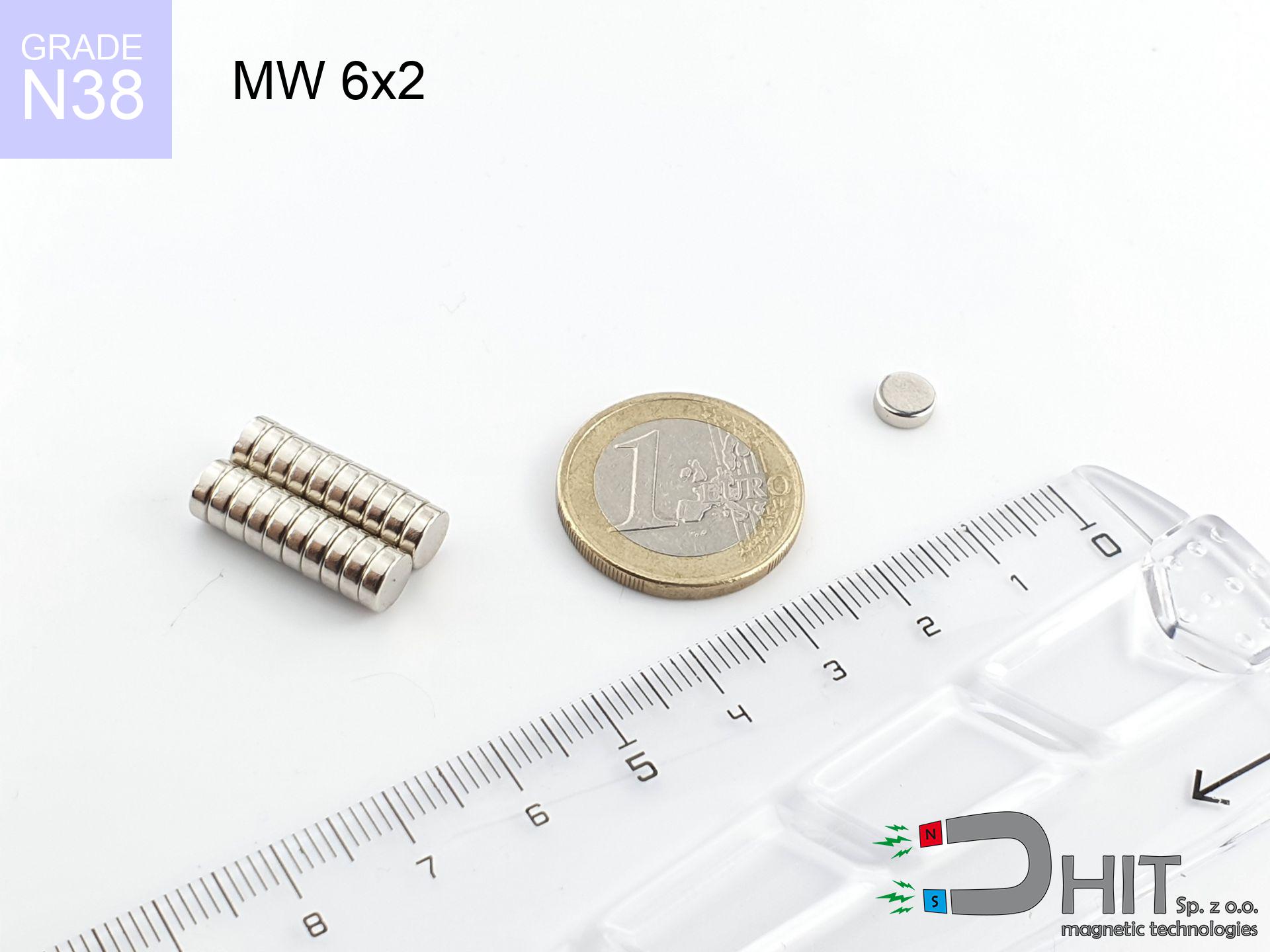SMZR 25x250 / N52 - magnetic separator with handle
magnetic separator with handle
Catalog no 140236
GTIN/EAN: 5906301813446
Diameter Ø
25 mm [±1 mm]
Height
250 mm [±1 mm]
Weight
840 g
Magnetic Flux
~ 9 500 Gauss [±5%]
676.50 ZŁ with VAT / pcs + price for transport
550.00 ZŁ net + 23% VAT / pcs
bulk discounts:
Need more?
Give us a call
+48 888 99 98 98
if you prefer let us know using
our online form
our website.
Specifications and appearance of magnets can be reviewed with our
our magnetic calculator.
Same-day processing for orders placed before 14:00.
Product card - SMZR 25x250 / N52 - magnetic separator with handle
Specification / characteristics - SMZR 25x250 / N52 - magnetic separator with handle
| properties | values |
|---|---|
| Cat. no. | 140236 |
| GTIN/EAN | 5906301813446 |
| Production/Distribution | Dhit sp. z o.o. |
| Country of origin | Poland / China / Germany |
| Customs code | 85059029 |
| Diameter Ø | 25 mm [±1 mm] |
| Height | 250 mm [±1 mm] |
| Weight | 840 g |
| Material Type | Stainless steel AISI 304 / A2 |
| Magnetic Flux | ~ 9 500 Gauss [±5%] |
| Size/Mount Quantity | 2xM8 |
| Polarity | circumferential - 9 poles |
| Casing Tube Thickness | 1 mm |
| Manufacturing Tolerance | ±1 mm |
Magnetic properties of material N52
| properties | values | units |
|---|---|---|
| remenance Br [min. - max.] ? | 14.2-14.7 | kGs |
| remenance Br [min. - max.] ? | 1420-1470 | mT |
| coercivity bHc ? | 10.8-12.5 | kOe |
| coercivity bHc ? | 860-995 | kA/m |
| actual internal force iHc | ≥ 12 | kOe |
| actual internal force iHc | ≥ 955 | kA/m |
| energy density [min. - max.] ? | 48-53 | BH max MGOe |
| energy density [min. - max.] ? | 380-422 | BH max KJ/m |
| max. temperature ? | ≤ 80 | °C |
Physical properties of sintered neodymium magnets Nd2Fe14B at 20°C
| properties | values | units |
|---|---|---|
| Vickers hardness | ≥550 | Hv |
| Density | ≥7.4 | g/cm3 |
| Curie Temperature TC | 312 - 380 | °C |
| Curie Temperature TF | 593 - 716 | °F |
| Specific resistance | 150 | μΩ⋅cm |
| Bending strength | 250 | MPa |
| Compressive strength | 1000~1100 | MPa |
| Thermal expansion parallel (∥) to orientation (M) | (3-4) x 10-6 | °C-1 |
| Thermal expansion perpendicular (⊥) to orientation (M) | -(1-3) x 10-6 | °C-1 |
| Young's modulus | 1.7 x 104 | kg/mm² |
Table 1: Rod construction
SMZR 25x250 / N52
| Parameter | Value | Description / Unit |
|---|---|---|
| Diameter (Ø) | 25 | mm |
| Total length | 250 | mm (L) |
| Active length | 230 | mm |
| Section count | 10 | modules |
| Dead zone | 20 | mm (Blaszka 2mm + Gwint 18mm) |
| Weight (est.) | ~933 | g |
| Active area | 181 | cm² (Area) |
| Housing material | AISI 304 | 1.4301 (Inox) |
| Surface finish | Ra < 0.8 µm | Polished |
| Temp. class | 80°C | Standard (N) |
| Force loss (at max °C) | -12.8% | Reversible loss (physics) |
| Force (calculated) | 22.6 | kg (theor.) |
| Induction (surface) | ~9 500 | Gauss (Max) |
Chart 2: Field profile (10 sections)
Chart 3: Temperature performance
Chemical composition
| iron (Fe) | 64% – 68% |
| neodymium (Nd) | 29% – 32% |
| boron (B) | 1.1% – 1.2% |
| dysprosium (Dy) | 0.5% – 2.0% |
| coating (Ni-Cu-Ni) | < 0.05% |
Ecology and recycling (GPSR)
| recyclability (EoL) | 100% |
| recycled raw materials | ~10% (pre-cons) |
| carbon footprint | low / zredukowany |
| waste code (EWC) | 16 02 16 |
Other proposals
Advantages as well as disadvantages of neodymium magnets.
Strengths
- They have constant strength, and over around ten years their performance decreases symbolically – ~1% (in testing),
- They do not lose their magnetic properties even under external field action,
- By covering with a reflective layer of silver, the element presents an professional look,
- The surface of neodymium magnets generates a unique magnetic field – this is one of their assets,
- Thanks to resistance to high temperature, they are able to function (depending on the shape) even at temperatures up to 230°C and higher...
- Thanks to versatility in forming and the ability to customize to client solutions,
- Wide application in advanced technology sectors – they are used in HDD drives, drive modules, precision medical tools, as well as complex engineering applications.
- Compactness – despite small sizes they provide effective action, making them ideal for precision applications
Weaknesses
- Susceptibility to cracking is one of their disadvantages. Upon strong impact they can break. We advise keeping them in a special holder, which not only secures them against impacts but also increases their durability
- We warn that neodymium magnets can lose their strength at high temperatures. To prevent this, we recommend our specialized [AH] magnets, which work effectively even at 230°C.
- Magnets exposed to a humid environment can corrode. Therefore during using outdoors, we suggest using waterproof magnets made of rubber, plastic or other material resistant to moisture
- Due to limitations in producing nuts and complex forms in magnets, we recommend using a housing - magnetic holder.
- Potential hazard resulting from small fragments of magnets are risky, in case of ingestion, which becomes key in the context of child health protection. Furthermore, small components of these devices are able to disrupt the diagnostic process medical in case of swallowing.
- High unit price – neodymium magnets have a higher price than other types of magnets (e.g. ferrite), which hinders application in large quantities
Holding force characteristics
Detachment force of the magnet in optimal conditions – what contributes to it?
- with the contact of a sheet made of low-carbon steel, ensuring full magnetic saturation
- whose transverse dimension is min. 10 mm
- with a plane free of scratches
- without the slightest clearance between the magnet and steel
- for force applied at a right angle (in the magnet axis)
- in neutral thermal conditions
Practical lifting capacity: influencing factors
- Clearance – the presence of foreign body (rust, tape, gap) interrupts the magnetic circuit, which lowers power steeply (even by 50% at 0.5 mm).
- Load vector – highest force is obtained only during perpendicular pulling. The shear force of the magnet along the plate is typically several times lower (approx. 1/5 of the lifting capacity).
- Substrate thickness – to utilize 100% power, the steel must be sufficiently thick. Thin sheet limits the lifting capacity (the magnet "punches through" it).
- Material composition – different alloys reacts the same. High carbon content weaken the interaction with the magnet.
- Surface condition – ground elements guarantee perfect abutment, which increases force. Uneven metal reduce efficiency.
- Thermal factor – hot environment reduces pulling force. Too high temperature can permanently damage the magnet.
Lifting capacity was assessed by applying a polished steel plate of optimal thickness (min. 20 mm), under vertically applied force, however under attempts to slide the magnet the lifting capacity is smaller. Additionally, even a slight gap between the magnet’s surface and the plate lowers the holding force.
Safety rules for work with NdFeB magnets
Implant safety
Health Alert: Neodymium magnets can turn off pacemakers and defibrillators. Stay away if you have medical devices.
Operating temperature
Monitor thermal conditions. Heating the magnet above 80 degrees Celsius will permanently weaken its magnetic structure and strength.
Avoid contact if allergic
It is widely known that nickel (standard magnet coating) is a strong allergen. If your skin reacts to metals, avoid direct skin contact or opt for encased magnets.
Danger to the youngest
Always keep magnets out of reach of children. Ingestion danger is significant, and the consequences of magnets connecting inside the body are fatal.
GPS and phone interference
A strong magnetic field disrupts the functioning of compasses in phones and GPS navigation. Do not bring magnets near a device to avoid damaging the sensors.
Protective goggles
Watch out for shards. Magnets can explode upon violent connection, ejecting sharp fragments into the air. We recommend safety glasses.
Combustion hazard
Powder generated during machining of magnets is flammable. Do not drill into magnets unless you are an expert.
Keep away from computers
Equipment safety: Neodymium magnets can damage data carriers and delicate electronics (heart implants, medical aids, timepieces).
Respect the power
Handle magnets consciously. Their immense force can surprise even experienced users. Be vigilant and do not underestimate their force.
Crushing risk
Danger of trauma: The pulling power is so great that it can cause hematomas, crushing, and broken bones. Use thick gloves.





![SM 32x450 [2xM8] / N42 - magnetic separator SM 32x450 [2xM8] / N42 - magnetic separator](https://cdn3.dhit.pl/graphics/products/sm-32x450-2xm8-bex.jpg)


